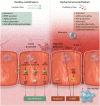Endothelial function in cardiovascular medicine: a consensus paper of the European Society of Cardiology Working Groups on Atherosclerosis and Vascular Biology, Aorta and Peripheral Vascular Diseases, Coronary Pathophysiology and Microcirculation, and Thrombosis
- PMID: 32282914
- PMCID: PMC7797212
- DOI: 10.1093/cvr/cvaa085
Endothelial function in cardiovascular medicine: a consensus paper of the European Society of Cardiology Working Groups on Atherosclerosis and Vascular Biology, Aorta and Peripheral Vascular Diseases, Coronary Pathophysiology and Microcirculation, and Thrombosis
Abstract
Endothelial cells (ECs) are sentinels of cardiovascular health. Their function is reduced by the presence of cardiovascular risk factors, and is regained once pathological stimuli are removed. In this European Society for Cardiology Position Paper, we describe endothelial dysfunction as a spectrum of phenotypic states and advocate further studies to determine the role of EC subtypes in cardiovascular disease. We conclude that there is no single ideal method for measurement of endothelial function. Techniques to measure coronary epicardial and micro-vascular function are well established but they are invasive, time-consuming, and expensive. Flow-mediated dilatation (FMD) of the brachial arteries provides a non-invasive alternative but is technically challenging and requires extensive training and standardization. We, therefore, propose that a consensus methodology for FMD is universally adopted to minimize technical variation between studies, and that reference FMD values are established for different populations of healthy individuals and patient groups. Newer techniques to measure endothelial function that are relatively easy to perform, such as finger plethysmography and the retinal flicker test, have the potential for increased clinical use provided a consensus is achieved on the measurement protocol used. We recommend further clinical studies to establish reference values for these techniques and to assess their ability to improve cardiovascular risk stratification. We advocate future studies to determine whether integration of endothelial function measurements with patient-specific epigenetic data and other biomarkers can enhance the stratification of patients for differential diagnosis, disease progression, and responses to therapy.
Keywords: Cardiovascular; Endothelial function.
Published on behalf of the European Society of Cardiology. All rights reserved. © The Author(s) 2020. For permissions, please email: journals.permissions@oup.com.
Figures


Similar articles
-
Methods for evaluating endothelial function: a position statement from the European Society of Cardiology Working Group on Peripheral Circulation.Eur J Cardiovasc Prev Rehabil. 2011 Dec;18(6):775-89. doi: 10.1177/1741826711398179. Eur J Cardiovasc Prev Rehabil. 2011. PMID: 21450600 Review.
-
Expert consensus and evidence-based recommendations for the assessment of flow-mediated dilation in humans.Eur Heart J. 2019 Aug 7;40(30):2534-2547. doi: 10.1093/eurheartj/ehz350. Eur Heart J. 2019. PMID: 31211361
-
Endothelial dysfunction and cardiovascular risk prediction in peripheral arterial disease: additive value of flow-mediated dilation to ankle-brachial pressure index.Circulation. 2003 Oct 28;108(17):2093-8. doi: 10.1161/01.CIR.0000095273.92468.D9. Epub 2003 Oct 6. Circulation. 2003. PMID: 14530195 Clinical Trial.
-
Diagnostic Criteria of Flow-Mediated Vasodilation for Normal Endothelial Function and Nitroglycerin-Induced Vasodilation for Normal Vascular Smooth Muscle Function of the Brachial Artery.J Am Heart Assoc. 2020 Jan 21;9(2):e013915. doi: 10.1161/JAHA.119.013915. Epub 2020 Jan 8. J Am Heart Assoc. 2020. PMID: 31910779 Free PMC article.
-
Clinical aspects of assessment of endothelial function.Pharmacol Rep. 2006;58 Suppl:33-40. Pharmacol Rep. 2006. PMID: 17332669 Review.
Cited by
-
Vascular function in patients with advanced heart failure and continuous-flow or pulsatile ventricular assist devices.Clin Res Cardiol. 2024 Aug 21. doi: 10.1007/s00392-024-02519-x. Online ahead of print. Clin Res Cardiol. 2024. PMID: 39167193
-
Influence of Spiritual Well-Being on Blood Pressure, Central Hemodynamics and Endothelial Function.Arq Bras Cardiol. 2022 Oct;119(4):622-626. doi: 10.36660/abc.20210886. Arq Bras Cardiol. 2022. PMID: 36287417 Free PMC article. English, Portuguese. No abstract available.
-
Single Nucleotide Polymorphisms in Coronary Microvascular Dysfunction.J Am Heart Assoc. 2024 Feb 20;13(4):e032137. doi: 10.1161/JAHA.123.032137. Epub 2024 Feb 13. J Am Heart Assoc. 2024. PMID: 38348798 Free PMC article. Review.
-
Endothelial Dysfunction and 6-Year Risk of Mortality in Kidney Transplant Recipients.Transplant Direct. 2021 Dec 13;8(1):e1262. doi: 10.1097/TXD.0000000000001262. eCollection 2022 Jan. Transplant Direct. 2021. PMID: 34912949 Free PMC article.
-
Cytosolic DNA initiates a vicious circle of aging-related endothelial inflammation and mitochondrial dysfunction via STING: the inhibitory effect of Cilostazol.Acta Pharmacol Sin. 2024 Sep;45(9):1879-1897. doi: 10.1038/s41401-024-01281-0. Epub 2024 Apr 30. Acta Pharmacol Sin. 2024. PMID: 38689095
References
-
- Kalucka J, Bierhansl L, Conchinha NV, Missiaen R, Elia I, Bruning U, Scheinok S, Treps L, Cantelmo AR, Dubois C, de Zeeuw P, Goveia J, Zecchin A, Taverna F, Morales-Rodriguez F, Brajic A, Conradi LC, Schoors S, Harjes U, Vriens K, Pilz GA, Chen R, Cubbon R, Thienpont B, Cruys B, Wong BW, Ghesquiere B, Dewerchin M, De Bock K, Sagaert X, Jessberger S, Jones EAV, Gallez B, Lambrechts D, Mazzone M, Eelen G, Li X, Fendt SM, Carmeliet P.. Quiescent endothelial cells upregulate fatty acid beta-oxidation for vasculoprotection via redox homeostasis. Cell Metab 2018;28:881–894.e13. - PubMed
-
- Shah AV, Birdsey GM, Peghaire C, Pitulescu ME, Dufton NP, Yang Y, Weinberg I, Osuna Almagro L, Payne L, Mason JC, Gerhardt H, Adams RH, Randi AM.. The endothelial transcription factor ERG mediates angiopoietin-1-dependent control of Notch signalling and vascular stability. Nat Commun 2017;8:16002. - PMC - PubMed
-
- Cardner M, Yalcinkaya M, Goetze S, Luca E, Balaz M, Hunjadi M, Hartung J, Shemet A, Kränkel N, Radosavljevic S, Keel M, Othman A, Karsai G, Hornemann T, Claassen M, Liebisch G, Carreira E, Ritsch A, Landmesser U, Krützfeldt J, Wolfrum C, Wollscheid B, Beerenwinkel N, Rohrer L, von Eckardstein A.. Structure-function relationships of HDL in diabetes and coronary heart disease. JCI Insight 2020;5:e131491. - PMC - PubMed
-
- Li X, Sun X, Carmeliet P.. Hallmarks of endothelial cell metabolism in health and disease. Cell Metab 2019;30:414–433. - PubMed
-
- Dikalov S, Itani H, Richmond B, Arslanbaeva L, Vergeade A, Rahman SMJ, Boutaud O, Blackwell T, Massion PP, Harrison DG, Dikalova A.. Tobacco smoking induces cardiovascular mitochondrial oxidative stress, promotes endothelial dysfunction, and enhances hypertension. Am J Physiol Heart Circ Physiol 2019;316:H639–H646. - PMC - PubMed

